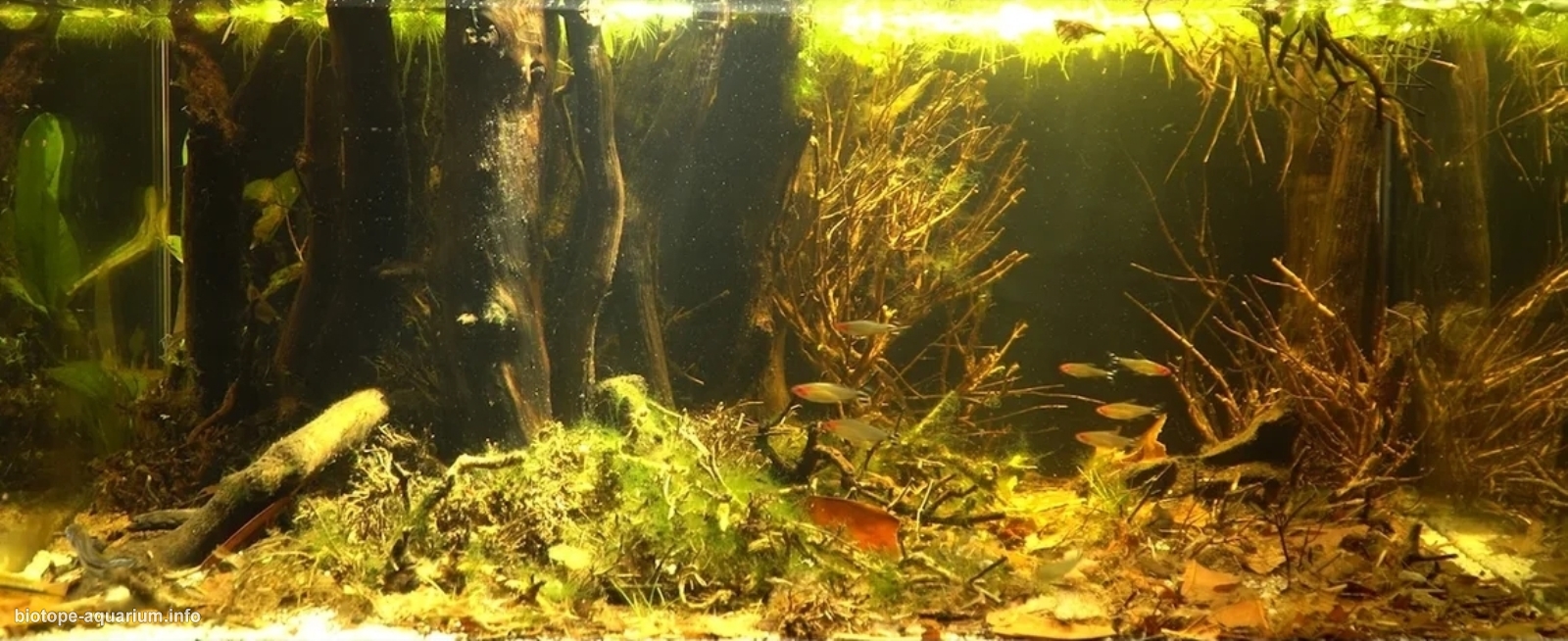Floresta Nacional de Tefé (Flona de Tefé)
_th place in Biotope Aquarium Design Contest 2020

Volume: 135 liters
Dimensions: 75x45x40 cm
List of fishes: Hemigrammus rhodostomus, Apistogramma Sp. Tefé, Carnegiella strigata
List of plants: Eleocharis parvula, Limnobium laevigatum, Echinodorus sp.
Description of decorations: Beige quartz sand (0.5.1mm) is used in the design of the aquarium so that it resembles the habitat of the region. Coconut coir, cocopeat and leaves are present on the top of the quartz sand. Oak trunk is used as the bigger piece. Thyme and various bushes are placed as the smaller stems. All the plants are specifically picked up from the nature.
Description of equipment: Filtration: JBL CristalProfi E902 external filter, Heating: Eheim Jager Heater 200W, Light: 40 W 6000K Spotlight, Creaqua 12.5W Nano Lite
Water parameters: Temperature: 26°C, pH: 5.8, ppm 60.
Additional info: Reverse osmosis water is used in the tank. Water is changed once a week %25. Seachem Equilibrium is used for the mineralisation. Besides, according to the measurements of the pH level, peat is changed approximately once in three months. And once in six months, filter equipments are cleaned. Filter equipments include bio sponge, Sera Super Peat and Sera Crystal Clear.
INFORMATION ABOUT BIOTOPE
Description of the area surrounding the biotope: The Tefé National Forest, or Floresta Nacional de Tefé, is a national forest in Amazonas, Brazil. It was created by federal decree 97.629 of 10 April 1989 with an estimated area of 1,020,000 hectares. It is classed as IUCN protected area category VI (protected area with sustainable use of natural resources). The forest became part of the Central Amazon Ecological Corridor, established in 2002.
The Tefé National Forest is divided between the municipalities of Tefé (46.27%}, Juruá (11.89%), Carauari (4.96%) and Alvarães (36.88%) in Amazonas. The forest is bounded by the Tefé River to the east, the Bauana River, a tributary of the Tefé, to the north, the Andirá River, a tributary of the Juruá River, to the west, and the Curumitá de Baixo River, a tributary of the Tefé, to the south. Access to Floresta Nacional de Tefé takes place exclusively by river, from the headquarters of the municipality of Tefé.
The climate of this region is typical to the Central Amazon, with a rainy season from February to April (300-150 mm / month) and a drier season from August to December (50-150 mm / month). The annual flood amplitude varies between 8 and 16 meters, reaching its peak between April and June, and its bottom in October.
In addition, the Tefé river basin in the east, its forests, rivers, canals and swamps are the largest flood basins in the region.
Description of the underwater landscape of the biotope: The underwater is blackwater, layered with fine sand, tree roots and leaves. In some regions trees are submerged into the water.
Description of the parameters of the habitat: The temperature varies between 25 and 31°C depending on the season. pH ranges from 4.8 to 5.8 but it never rises above 6. TDS is approximately 30µS.
List of fishes and invertebrates occurring in the nature biotope: Aphyodite tupebas, Steatogenys ocellatus, Hemigrammus rhodostomus, Apistogramma sp.Tefe, Carnegiella strigata, Symphysodon aequifasciatus, Apistogramma bitaeniata, Corydoras eques, Corydoras elegans, Brachyhypopomus hendersoni.
List of plants found in the nature biotope: Salvinia, Echinodorus spp., Eleocharis parvula, Limnobium laevigatum.
Threats to the ecology: The forest is administrated by The Chico Mendes Institute for Biodiversity Conservation. Although it is prohibited, the hunting of the wild animals, especially mammals, is tolerated in some situations. Hunting is seen as some sort of a protein resource and it is endangering the region. Logging is a new means of living in the area, however, the forest is susceptible to degradation due to misuse and needs to be protected. The urban area of Tefé is located between two water courses, which means that a large part of its area is exposed to the drought and flooding regime. In addition, the researches indicated that the hunting of the fishes which are below the authorised size is endangering the species.
Sources of information:
https://tefe.am.gov.br/
https://uakari.mamiraua.org.
https://uc.socioambiental.org/
https://www.seriouslyfish.com/
http://www.scielo.br/scielo.
https://instagram.com/
https://www.fishbase.se/
